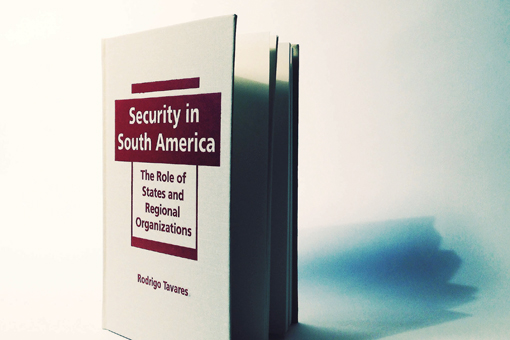Nowhere in the world is the web of treaties, agreements and agencies concerned with regional security needs as thick as in Latin America. The region has seen one of the most dramatic institutional transformations of the late twentieth and early twenty-first century. Among the many reasons for this transformation is the widespread rejection of U.S. leadership to resolve problems considered to be unique to the global South.
Latin American leaders prefer to characterize their region as a “zone of peace”—distant from the traditional rivalries and brinksmanship of the Cold War. But in his new book, Security in South America: The Role of States and Regional Organizations, Rodrigo Tavares, an associate research fellow at the United Nations University and and an assistant professor of international relations at the Fundação Getúlio Vargas, challenges this notion. He wonders whether it’s really possible to think of South America as peaceful, given the widespread threats to public safety and citizen security throughout the continent.
According to the United Nations Office on Drugs and Crime (UNODC), 36 percent of all homicides globally take place in the Americas. And Venezuela, once a relatively peaceful nation, is now one of the most dangerous places to live. It is clear, Tavares argues, that the South American “peace” that regional leaders celebrate does reflect reality, and there is a distinction to be made between security and peace. The former, he points out, is about the management of threats, “whereas peace is about the management of violence.” Regional institutions focus on security cooperation, not necessarily peace.
This is one of the key challenges produced by the surge in security-oriented multilateralism: can these new institutional arrangements really address the region’s human security needs, or do they rely too much on the same national security mindset that Latin American leaders often belittle in the United States?
Tavares draws a sharp contrast between the national security concerns of states in the post-Cold War era and the more pervasive public security threats that have taken a heavy toll in terms of violence, insecurity and loss of life throughout the region. In his thorough, almost encyclopedic summary of the region’s multilateral security arrangements, he makes clear that few of them measure up to the needs of “public” rather than “state” security.
“It is difficult to envisage a peace zone where 32 non-armed conflicts (11 territorial disputes, 19 domestic political crises and two other non-armed disputes) have occurred since the end of the Cold War,” he notes. However, despite increased threats in the Americas, Tavares points out that the rhetoric on security has not changed.
How can we continue to talk about South America as a zone of peace if the violence resulting from the drug trade and access to firearms remains a scourge on communities around the Americas? He argues that human security—the term given to a wide range of factors that include access to justice, community policing and public safety—is a basic need that requires action at national and regional levels.
Despite the expansion of regional organizations purportedly created to address new threats, little has been done to reconceptualize the security framework guiding these new bodies, Tavares argues.
The use of military structures left over from previous dictatorships as policing bodies is one example of a security framework that may need to be rethought. In Brazil, as in other places in the region, the military is now serving as a policing body, in part due to the notorious corruption and ineffectiveness of law enforcement. Whether use of the armed forces for public security is sustainable—or advisable—is being questioned by civil society groups in Brazil, who cite numerous accounts of human rights abuses by the military.
Tavares’ contribution to the literature is important as a catalogue of the regional arrangements that can address these new security challenges—and those that can’t. At the heart of the problem, he notes, is that many of these organizations have no institutional capacity to implement decisions. La Unión de Naciones Suramericanas (Union of South American Nations—UNASUR), created in 2008, and the Comunidad de Estados Latinoamericanos y Caribeños (Community of Latin American and Caribbean States—CELAC) in 2011, are relatively weak bodies with understaffed secretariats. The Alianza Bolivariana para los Pueblos de Nuestra América (Bolivarian Alliance for the Peoples of Our America—ALBA), is more an ideological formation than an action-oriented body.
Tavares finds this, coupled with the diminished power—both financial and political—of the Organization of American States (OAS) as a forum to solve problems very troubling.
UNASUR was only successful in mediating a peaceful outcome in the cases of Bolivia in 2003 and 2005, and Paraguay in 2012. Venezuela may also prove to be a situation where using UNASUR to negotiate may yield a better outcome than an OAS solution, as many in the region perceive the hemispheric body as tainted by Washington politics.
However, Tavares notes that it took the OAS to manage the 2008 border skirmish between Colombia and Ecuador because it was—at the time—the only organization with a mandate for conflict prevention.
Excellent sections on five of the region’s 12 countries—Argentina, Brazil, Chile, Colombia, and Venezuela—shed light on the national politics of multilateralism. As Tavares contends in his last chapter, “cooperation can sometimes be hijacked by ideology” in a region where nationalism trumps multilateralism. Too many countries still hide behind the veil of sovereignty as a way of evading action on problems that require a more operational approach to protecting democracy and human rights.
Tavares’ careful research makes this an important—and overall balanced—take on security and multilateralism. His compelling argument questioning the “zone of peace” framework is also a call for increased scholarship and dialogue on addressing human insecurity as a transnational challenge. This makes the book a must-read for those dissatisfied with international relations theorists who miss the nuances of today’s regional organizations.






